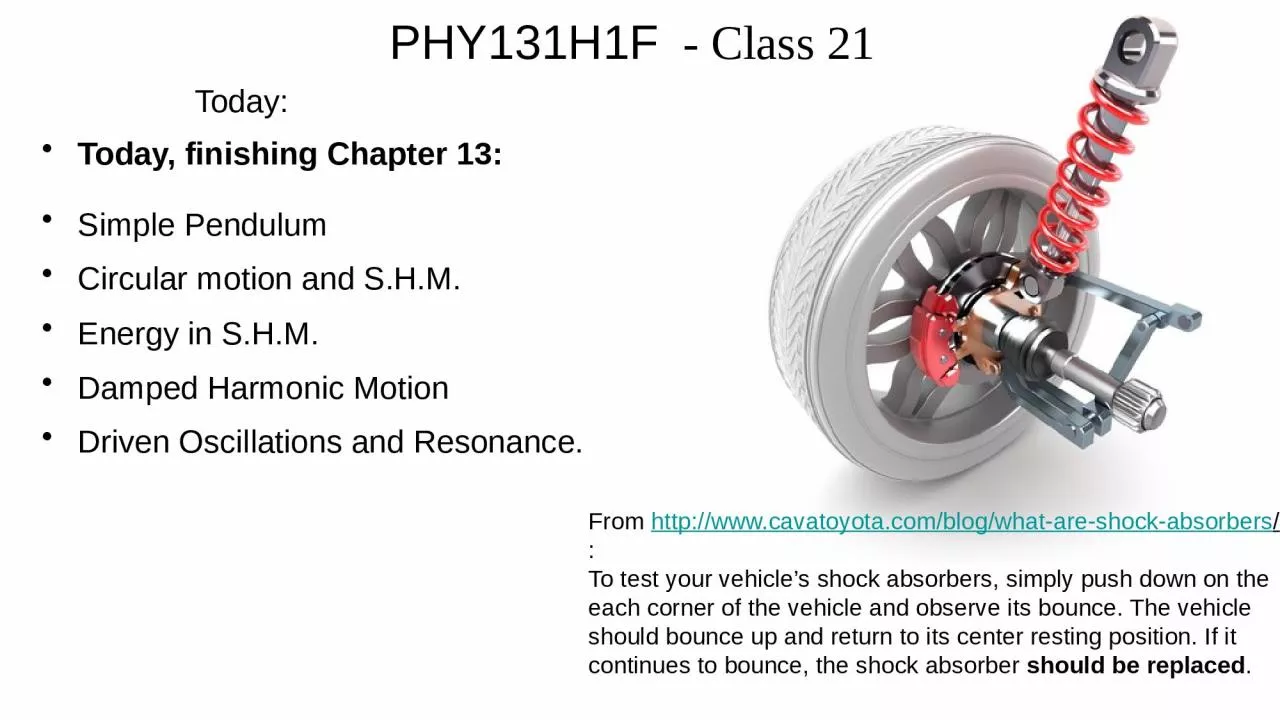

Today finishing Chapter 13 Simple Pendulum Circular motion and SHM Energy in SHM Damped Harmonic Motion Driven Oscillations and Resonance From httpwwwcavatoyotacomblogwhatareshockabsorbers ID: 1031565
Download Presentation The PPT/PDF document "PHY131H1F - Class 21 Today:" is the property of its rightful owner. Permission is granted to download and print the materials on this web site for personal, non-commercial use only, and to display it on your personal computer provided you do not modify the materials and that you retain all copyright notices contained in the materials. By downloading content from our website, you accept the terms of this agreement.
1. PHY131H1F - Class 21Today:Today, finishing Chapter 13:Simple PendulumCircular motion and S.H.M.Energy in S.H.M.Damped Harmonic MotionDriven Oscillations and Resonance.From http://www.cavatoyota.com/blog/what-are-shock-absorbers/ :To test your vehicle’s shock absorbers, simply push down on the each corner of the vehicle and observe its bounce. The vehicle should bounce up and return to its center resting position. If it continues to bounce, the shock absorber should be replaced.
2. What is the net torque on this pendulum?
3. So the simple harmonic motion equation for θ as a function of time is: The solution to this is , where A and are arbitrary, and the frequency of oscillations (in rad/s) is: Suppose we restrict a pendulum’s oscillations to small angles (< 10°). Then we may use the small angle approximation sin θ ≈ θ, where θ is measured in radians. The net torque on the mass isBut the rotational inertia of a point mass m a distance L from the rotation axis is I = mL2, so
4. Two pendula have the same length, but different mass. The force of gravity, F=mg, is larger for the larger mass. Which will have the longer period?A. the larger massB. the smaller massC. neitherLearning Catalytics Question 1
5. Example. Luke and Leia have a combined mass of 120 kg and both grasp a rope of length 30 m that is attached to a beam above them. The beam is half-way across a 10 m horizontal gap, and they want to swing across. If they start from rest and swing down and up, just reaching the other side, how long does this take?
6.
7. Mass on Spring versus PendulumMass on a SpringPendulumCondition for S.H.M.Small oscillations (Hooke’s Law is obeyed)Small anglesAngular frequencyPeriod
8. A person swings on a swing. When the person sits still, the swing oscillates back and forth at its natural frequency. If, instead, the person stands on the swing, the natural frequency of the swing isA. greaterB. the sameC. smallerLearning Catalytics Question 2
9. A grandfather clock at high altitudes runsA. fast.B. slow.C. normally as it does at sea level.Image from https://www.1-800-4clocks.com/Bulova-Vickery-Wall-Chimes-Clock_C4329_CUVLearning Catalytics Question 3
10. Uniform Circular MotionSimple Harmonic Motion
11.
12. Energy of a mass on a spring
13. equilibrium
14.
15. Simple Harmonic Motion (SHM)If the net force on an object is a linear restoring force (ie a mass on a spring, or a pendulum with small oscillations), then the position as a function of time is related to cosine:Cosine is a function that goes forever, but in real life, due to friction or drag, all oscillations eventually slow down.
16.
17. Damped OscillationsWhen a mass on a spring experiences the force of the spring as given by Hooke’s Law, as well as a drag force of magnitude |D|=bv, the solution is
18. Example 13.6.A car’s suspension acts like a mass-spring system with m = 1200 kg and k = 5.8 × 104 N/m. Its shock absorbers provide a damping constant of b = 230 kg/s. After the car hits a bump in the road, how many oscillations will it make before the amplitude drops to half its initial value?
19. Damped Harmonic Motionunderdampedcritically damped, and overdamped oscillations.
20. Driven Oscillations and Resonance Consider an oscillating system that, when left to itself, oscillates at a frequency f0. We call this the natural frequency of the oscillator. Suppose that this system is subjected to a periodic external force of frequency fext. This frequency is called the driving frequency. Driven systems oscillate at fext. The amplitude of oscillations is generally not very high if fext differs much from f0. As fext gets closer and closer to f0, the amplitude of the oscillation rises dramatically.
21. 14.8 Externally Driven OscillationsResonance!
22. Before Class 22 on MondayIf you haven’t done it, please check your utoronto email, respond to the course_evaluations email and evaluate this course!Image from http://freger.weebly.com/the-five-senses.html Something to think about over the weekend: Two of the five senses depend on waves in order to work: which two?Please start reading Chapter 14 on Waves and/or watch the Preclass 22 video. Note that we will only cover the first seven sections of chapter 14 for this course (No Doppler shift)